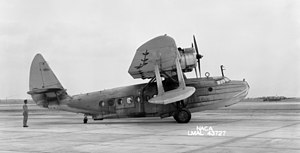Sikorsky S-43
| S-43 (JRS-1) | |
|---|---|

| |
| U.S. Navy Sikorsky JRS-1 in 1945 | |
| Role | Flying boat airliner |
| National origin | United States |
| Manufacturer | Sikorsky Aircraft |
| Designer | Igor Sikorsky |
| First flight | 1935 |
| Introduction | 1934 |
| Primary user | Pan American Airways |
| Number built | 53 |
The Sikorsky S-43 was a twin engine amphibious aircraft manufactured in United States during the 1930s by the American firm Sikorsky Aircraft.
Design and development
The S-43 first flew in 1935, and was a smaller version of the Sikorsky S-42 "Clipper". It accommodated between 18 and 25 passengers, with a separate two-crew forward cockpit.[1] The S-43 was known as the "Baby Clipper" in airline service.
On April 14, 1936, An S-43 with a 500 kilograms (1,100 lb) payload and piloted by Boris Sergievsky set an altitude record for amphibious aircraft when it reached an altitude of 27,950 feet above Stamford, Connecticut. Also aboard was designer Igor Sikorsky.[2]
In total, approximately 53 S-43s were built, including examples of the twin-tailed S-43B.[3]
Operational history


The S-43 was used primarily by Pan American World Airways for flights to Cuba and within Latin America. Two were also flown by Reeve Aleutian Airways in Alaska and three were used by Inter-Island Airways of Hawaii, the predecessor to modern-day Hawaiian Airlines, to ferry Pan-Am Clipper passengers and local residents from Honolulu to the other islands. One aircraft was purchased by Norwegian airline Det Norske Luftfartselskap. Panair do Brasil operated seven aircraft.
Five aircraft were acquired by the U.S. Army Air Corps in 1937 under the designation OA-8 and were used for transport of freight and passengers.[4] 17 aircraft were procured by the U.S. Navy between 1937 and 1939 as the JRS-1, two of which served the U.S. Marine Corps. One JRS survived in service at the end of 1941.[5]
The Smithsonian National Air & Space Museum's Steven F. Udvar-Hazy Center in Virginia is currently restoring a Sikorsky JRS-1 that was on duty at Pearl Harbor on December 7th, 1941.[6]
Two aircraft went to private owners: Harold Vanderbilt and Howard Hughes. Hughes' S-43 N444 remains the last example of this aircraft type flying [1]. It is now owned by Kermit Weeks and in the process of being relocated from Texas to the Fantasy of Flight Museum in Polk City, Florida. It is expected to arrive there for reassembly after shipping by road before the end of 2013.
Accidents and incidents
- June 2, 1937: A Linea Aerea Nacional de Chile S-43 disappeared over the Sea of Chile with 9 on board.
- August 2, 1937: A Pan Am Grace Airways (Panagra) S-43NC 15065 crashed in the vicinity of Coco Solo, Canal Zone; all 14 on board died. The plane spiraled into the water at approximately 90 mph and was destroyed by an immediate explosion and fire. Most probable cause of the crash was failure of one or both of the engines due to a faulty gasoline system and/or sudden and severe rain, as the pilot indicated losing altitude two times in the three minutes prior to the crash.
- August 8, 1937: A China National Aviation Corporation (CNAC) S-43 ditched at Chilang Point, Bias Bay, China, killing the three crew; all 8 passengers survived. The flying boat was forced to ditch due to bad weather. High waves broke one wing off; the 8 passengers clung to the other wing until rescued.
- May 17, 1943: Hughes crashed his S-43 into Lake Mead, killing CAA inspector Ceco Cline and Hughes employee Richard Felt. The aircraft was later raised and restored to flying condition.
Specifications (S-43)
General characteristics
- Crew: two (pilot, copilot)
- Capacity: 19 passengers
- Length: 51 ft 2 in (15.60 m)
- Wingspan: 86 ft 0 in (26.21 m)
- Height: 17 ft 8 in (5.38 m)
- Wing area: 781 ft² (72.5 m²)
- Empty: 12,750 lb (5,783 kg)
- Loaded: lb ( kg)
- Maximum takeoff: 19,096 lb (8,662 kg)
- Powerplant: 2× Pratt & Whitney R-1690-52 radials, 750 hp (560 kW) each
Performance
- Maximum speed: 190 mph (306 km/h)
- Range: 775 miles (1,247 km)
- Service ceiling: 20,700 ft (6,310 m)
- Rate of climb: ft/min ( m/min)
- Wing loading: lb/ft² (115.84 kg/m²)
- Power/mass: hp/lb ( kW/kg)
See also
Related development
Related lists
References
- Notes
- ^ Simpson, 2001, p. 499
- ^ Special to the New York Times. "Sikorsky Amphibian Climbs to 27,950 Feet; Two World Altitude Records Are Claimed", The New York Times. April 15, 1936. Page 1.
- ^ Simpson, 2001, p. 499
- ^ Swanborough, 1963, p. 528
- ^ Swanborough, 1990, p. 524
- ^ "Sikorsky JRS-1."Smithsonian National Air and Space Museum. Retrieved: 15 June 2013.
- Bibliography
- Simpson, Rod (2001). Airlife's World Aircraft. Airlife Publishing Ltd. ISBN 1-84037-115-3.
- Swanborough, Gordon (1963). United States Military Aircraft since 1909. Putnam & Co. Ltd.
- Swanborough, Gordon (1990). United States Navy Aircraft since 1911. Putnam Aeronautical Press. ISBN 0-87021-792-5.
External links
- Video - Howard Hughes Sikorsky S-43
